A Return to Memory
A Return to Memory
Donald McWilliams
2024
| 116 min
Feature Documentary
English
When Canada entered World War II, the National Film Board suddenly had an urgent new mission—and hundreds of women stepped forward, helping to create Canadian cinema as we now know it.
“We learned to work with chaos.”
The intrepid women who helped create Canadian cinema come to vibrant life in A Return to Memory, a documentary masterwork illuminating their vital but little-known role in establishing Canada’s National Film Board.
Juxtaposing a dazzling array of archival material with dynamic animation by NFB infographics artist Mélanie Bouchard, director Donald McWilliams evokes the heady wartime years, when women played a key part in transforming the NFB into a major international studio.
With men engaged elsewhere in the war effort, hundreds of women pursued careers at the newly formed public producer—and pioneering figures like Evelyn Spice Cherry, Red Burns and Jane Marsh Beveridge made movie history, creating work that spoke to the world with a distinctive Canadian voice.
Long Synopsis
The date: 1942. The place: the lobby of Winnipeg’s Fort Garry hotel.
Winnipeg Free Press reporter Gudrun Bjerring sits down to interview John Grierson, head of the National Film Board of Canada. Established in 1939, the public studio has quickly pivoted to become the nation’s wartime propaganda voice.
By the end of the encounter, Grierson offers her a job—and she’s destined to become one of Canada’s first women filmmakers, one of hundreds of women “filmworkers” hired by Grierson when Canadian men went off to fight.
Bjerring is among an extraordinary cohort of women featured in A Return to Memory, a masterwork of archival cinema that explores little-known cultural history, acknowledging the vital role women played in the birth of a unique Canadian cinema.
Juxtaposing a dazzling array of archival material with dynamic animation by NFB infographics artist Mélanie Bouchard, director Donald McWilliams evokes a heady time when these women were helping to produce films that circled the globe—films that spoke to the world with a distinctly Canadian sensibility.
Some were seasoned pros—like Evelyn Spice Cherry, who’d been active in the groundbreaking British Documentary Film Movement during the 1930s, and Hollywood editor Helen Lewis, who’d cut movies for von Sternberg, among others—but most were eager beginners like Bjerring.
“We learned to work with chaos,” says Red Burns. Arriving at the NFB as a precocious 16-year-old, Burns went on to co-found NYU’s Tisch School of the Arts, crediting the NFB with inspiring a lifelong engagement with media and film.
She’s just one of many NFB women “filmworkers” who helped lay the foundations of Canadian cinema as we now know it. Among those featured in A Return to Memory are Jane Marsh Beveridge, renowned for infusing NFB propaganda with a feminist gaze; Evelyn Lambart, who was Canada’s first woman animator; Gretta Ekman, an experimental director whose filmmaking career foundered during the postwar Red Scare; and Grierson’s own sister Ruby, a documentary pioneer in her own right who died, torpedoed at sea, filming for the NFB. Also in the mix are behind-the-scenes players like Margaret Ann Bjornson Elton, dubbed “the greatest born thief of film” in recognition of her gift for unearthing and repurposing footage, a valued skill during frenzied wartime production, and Helen Watson, who oversaw a nationwide team of travelling projectionists.
Woven throughout is remarkable footage from “Four Days in May,” a 1975 reunion hosted by Studio D, the NFB’s now defunct women’s filmmaking unit. The wartime women look back on their time together—and decades later, their spirited and wide-ranging discussion still resonates with contemporary relevance.
About the Women
Gudrun Bjerring Parker (1920–2022)
Gudrun Bjerring Parker was a young newspaper reporter when she met John Grierson, interviewing him in the lobby of a Winnipeg hotel. Impressed by her journalistic skills, he offered her a job on his wartime team. She arrived with no film experience but was soon directing her own work. Her first credits were on a series of educational shorts about vitamins, shot by Judith Crawley, another pioneering woman filmmaker. With films like Before They Are Six (1943) and Listen to the Prairies (1945), Bjerring Parker would bring a distinctive new lyricism to the documentary form. In 1944, she was appointed head of the NFB’s new Educational Unit and was able to follow her passion for education and the art of filmmaking, winning awards for Children’s Concert (1949) and Opera School (1951). She married fellow NFB filmmaker Morton Parker, working with him on the Oscar-nominated The Stratford Adventure (1953). In 1963, the couple launched their own production company, Park Film Associates. During her long career, Bjerring Parker produced or directed over 50 films. She was named to the Order of Canada in 2006.
Goldie “Red” Burns (née Goldie Gennis) (1925–2013)
Goldie Gennis—or Red Burns, as she came to be known—was a precocious 16-year-old in 1941 when she planted herself outside Grierson’s office, itching to work at the newly established public producer. He capitulated and she landed a job in technical services, kicking off an extraordinary career. When she died in 2013, The New York Times referred to her as the “Godmother of Silicon Alley,” acknowledging her pioneering work in film and new media. With George Stoney, an early producer in the NFB’s Challenge for Change program, Burns co-founded the Interactive Telecommunications Program at New York University’s Tisch School of the Arts, serving as its Chair for over 20 years.
Jane Marsh Beveridge (née Jane Smart) (1915–1998)
Ottawa-born Jane Marsh Beveridge joined the NFB in 1941, working first as a screenwriter but graduating quickly to directing shorts for Canada Carries On and The World in Action, newsreel series that got wide theatrical distribution. She brought an early feminist sensibility to Women are Warriors (1942) and Wings on Her Shoulder (1943), propaganda shorts urging women’s participation in the war effort. She would write, direct and edit Terre de nos Aieux (1943), one of the first NFB films to be made by an all-woman crew. She left the NFB in 1944 following a disagreement with Grierson, moving to New York where she worked on the Act and Fact newsreels for British Information Services. She later abandoned filmmaking, pursuing a career as a teacher and sculptor. Her sister was poet/novelist Elizabeth Smart, author of By Grand Central Station I Sat Down and Wept.
Gretta Ekman (1916–2004)
Gretta Ekman was a talented young artist, working for Ottawa’s geodetic survey, when her friend, producer Robert Verrall, urged her to join the NFB. Impressed by her skills, Norman McLaren encouraged her to make her own animated film. “She’s the only Canadian artist whom I have tried to encourage in hand-drawn animation who’s taken it up seriously,” he later remarked. The result was the hand-drawn animation Twirligig (1952). McLaren sent a 3D version of the film to the Festival of Britain—but when NFB management learned that Ekman had attended leftwing meetings as a student, they cancelled her contract and removed her name from the film’s credits. McLaren and composer Maurice Blackburn protested by stripping their own credits from the film, and it was only in 2011, when Canadian animator and scholar Alison Reiko Loader happened upon the Twirligig materials in the British Film Institute, that the film was restored and rereleased—complete with original credits.
Evelyn Spice Cherry (1906–1990)
A documentary pioneer and lifelong activist, Saskatchewan-born Evelyn Spice trained as a journalist before moving to the UK in 1931, finding work with Grierson at the GPO’s newly established film unit. She impressed critics with Weather Forecast, a poetic documentary on forecasting methods. In 1941, she and her husband, fellow filmmaker Lawrence Cherry, accepted Grierson’s invitation to join the NFB, where she played a key role in forging the new agency’s public mandate. As co-head of the NFB Agricultural Unit, she documented the emergence of agricultural co-ops and other social issues. Her leftwing convictions became a liability during the postwar Red Scare, and in 1950 she was pressured into leaving the NFB. She and her husband later formed Cherry Films Ltd, and by the time she retired in 1985, she’d produced and/or directed over 100 films.
Ruby Grierson (1904–1940)
Ruby Grierson, one of John Grierson’s six sisters, trained as a teacher before venturing into documentary production. Working as an uncredited assistant on the seminal documentary Housing Problems, she quickly started directing her own work, socially conscious documentaries like London Wakes Up and Today and Tomorrow. By engaging her subjects, often working-class women, directly in production, Grierson anticipated the ethos of the NFB’s Challenge for Change by several decades. Actively involved in the early war effort, she died in 1940, a passenger on a ship that was torpedoed during a transatlantic crossing. She was working for the NFB at the time, making a film on the wartime evacuation of British children to Canada. Released as Children from Overseas (1940), the film was initially credited to Stanley Hawes alone, but in 2020, Grierson was finally given a co-director credit. She is the subject of Fiona Adams’ documentary Ruby Grierson: Reshooting History, made for BBC Scotland.
Helen Lewis (1898?–1987)
Helen Lewis was already a seasoned editor, having worked with big-name directors like Josef von Sternberg, when she arrived at the NFB in the early 1940s. She had met John Grierson in Los Angeles while he was there giving a lecture. He persuaded her to join his busy wartime team, and over the next decade she would edit numerous NFB productions, often working with a cigarette dangling from her lips, bringing a wealth of experience to the recently founded public producer. She went on to work as an editor at CBC-TV and to be active with the Canadian Film Editors Guild.
Helen Watson Gordon (1918–2016)
Although only 24 when she joined the NFB, Helen Watson arrived with considerable organizational experience, having already managed educational projects in Manitoba. She was quickly running the NFB Rural Circuits, a novel initiative that sent over 100 travelling projectionists into communities across the country. Millions of Canadians would see themselves on film for the first time. In 1946, she was sent to Australia, working as a representative of the NFB and doing similar work for the Australian Film Board. Here she met her future husband, American diplomat Herb Gordon, and in 1954 the couple was posted to India where she helped set up an international school, supporting the charitable work of Mother Teresa, and played host to such luminaries as Duke Ellington, Martin Luther King and Edward Kennedy.
Alma Duncan (1917–2004)
Having worked as a commercial artist, Alma Duncan joined the NFB’s Graphic Arts Division in 1943, designing posters and publicity materials while pursuing an active independent career, documenting aspects of the war effort through her drawings and paintings. When the Graphic Arts Division was disbanded, she moved to the animation studio, directing Folksong Fantasy (1950). In 1951, she and Audrey McLaren, a fellow NFB worker who became her life partner, founded Dunclaren Production, creating animation like Kumak the Sleepy Hunter. Duncan remained active into the 1980s, participating in exhibitions in Canada and abroad. Her work appears in numerous public collections, and in 2014 the Ottawa Art Gallery mounted a major exhibition of her work.
Evelyn Lambart (1914–1999)
Considered Canada’s first woman animator, Evelyn Lambart was a young art school graduate when she began working at the NFB’s Ottawa headquarters in 1942. Put to work on wartime newsreels, she displayed a unique talent for crafting animated maps and graphics, and in 1947 she directed her first film, an inventive educational short called The Impossible Map. She was a close collaborator of Norman McLaren and together they co-directed six films, including the extraordinary Begone Dull Care (1949). Her solo efforts include Mr. Frog Went A-Courting (1974), a masterwork of cut-out animation. Hearing impaired from a young age, she credited the condition with heightening her attention to visual detail. The NFB remained her creative home until she retired.
Q&A with director Donald McWilliams
What was the genesis of A Return to Memory?
It started in 2017 when Hocine Cherifi, a conservation supervisor in the NFB vaults, came across a box of old 3/4-inch Betacam tapes. He thought they might be of interest, and Michelle van Beusekom, who was Executive Director of English Program at the time, asked me to take a look. We were worried we’d damage the tapes by running them through the old Beta players, so we digitized them as we watched them—and what we found was material Roger Blais had shot for a film he was making about John Grierson, the NFB’s first commissioner. Amongst the material were 78 minutes of an event called “Four Days in May,” a reunion organized in 1975 by Studio D, the newly founded women’s studio.
Studio D published a monograph after the reunion, so I knew something about it, but now we had actual footage. The 78 minutes captured only part of the event, but the discovery nonetheless opened a new window. Clearly there was much more to early NFB history than we had thought: to put it simply, the role of women had largely been ignored. So Michelle van Beusekom opened an “investigate.” Our working title was NFB Women, the title of the Studio D monograph. Back then we thought it was going to be quick and straightforward, but we had no idea of the wealth of material that we’d unearth.
This project required extensive research. Tell us something about that process.
Well, it’s taken far longer than anticipated—and the pandemic didn’t help—but two important things happened early on. When we went looking for the remaining footage from “Four Days in May,” we learned it had been discarded—a major loss—but then Katherine Kasirer, the NFB librarian, discovered that Roger Blais had placed some NFB material in the Rare Books and Special Collections at McGill University. Through the dogged efforts of Alison Burns, our lead researcher, we eventually managed to get access to this material, and we found the outs from Roger Blais’ Grierson film, including a pristine print of the 78 minutes. What we’d digitized from the Beta tapes was substandard quality, so this was a valuable find. In addition, there was a lot of new sound material on magnetic tape.
The second thing was information we gleaned from the Studio D monograph. On the last page was a memo from Clyde Owen, a supervisor in the lab, providing a long list of women’s names, people who’d worked technical jobs in those early years. I brought this list to the NFB photothèque, where Josée Laliberté did amazing work for us. Her knowledge of the Film Board was voluminous. She’d descend into the depths of the Board, retrieving boxes of old photos, images of these women in the 1940s. I eventually scanned more than 750 of these photographs and many appear in the final film.
Alison took on the important job of contacting surviving family members of our subjects. In the case of Helen Watson Gordon, a fascinating character who helped set up the rural circuits, Alison managed to track down her daughters in Connecticut. They sent us four boxes of material—all of Helen’s NFB correspondence, along with her teenage diaries and photos of her with such people as Mother Teresa and the Kennedys, taken during her post-NFB career in India.
In the end we used material from a multitude of sources, so it’s been a gargantuan effort, and I couldn’t have done it without Alison Burns and Josée Laliberté. Both were invaluable collaborators. Mélanie Bouchard has also been involved from early on, creating beautiful graphic sequences. And I’ve had great support from Michelle van Beusekom, who got the whole thing started, and from my producers, Annette Clarke, Kat Baulu and Ariel Nasr. And also from NFB Technical Services, who grasped the importance of what we were doing.
You’ve unearthed any number of fascinating stories. Any in particular you’d like to mention?
Women have generally been overlooked in the various written histories of the NFB, so there were plenty of discoveries. Red Burns, for example, was someone I’d never heard of, I’m ashamed to say. And Helen Lewis was another, an editor who worked with major directors like Josef von Sternberg. We found a hilarious interview with her—about how she met Grierson in Hollywood and how he cajoled her into joining his team.
There are a number of familiar names that we now see in a new light, people like Gudrun Bjerring Parker, for example. Film historians often point to Unit B films like Corral and Paul Tomkowicz as the beginning of Canada’s distinct documentary tradition, but Bjerring Parker was doing it first, with films like Listen to the Prairies and Before They Are Six.
Then there’s the story of the Red Scare and its impact on the NFB. Evelyn Spice Cherry, who was an important member of Grierson’s early team in England, was more or less pushed out in 1950 because of her leftwing leanings. She at least went on to make other films, but others weren’t so lucky. Few people will have heard of Gretta Ekman, for example, a brilliant young animator, very much admired by McLaren. She made a remarkable short called Twirligig—a film that got released in 3D—but which was buried by the NFB because of Ekman’s suspected leftwing leanings. So we brought her back from the shadows.
And there were plenty of stories we had to cut due to time restraints, such as that of the pioneer Canadian modernist poet Joyce Anne Marriott, the author of an extraordinary narrative poem called “The Wind Our Enemy,” who wrote scripts at the NFB. So there are many stories still to be told.
And then there’s the little-known story of Grierson’s sister…
Yes, Ruby Grierson, who turns out to have been a major talent in her own right. I remember Norman McLaren mentioning her to me in one of our early conversations. He’d met her while they were both working under John Grierson at the GPO Film Unit, and she made a strong impression on him. Here was this young woman, going into slums to interview people ignored by society. She wasn’t credited for the groundbreaking interviews she did for Housing Problems, perhaps the first documentary in which we hear the voices of working-class people, speaking directly to the camera about their lives. She died young, at the age of 36, while working for the NFB. She was making a film about the wartime evacuation of British children to Canada, and their ship was torpedoed. The film was released in 1940 as Children from Overseas, but it took years before Ruby got a co-director credit on the production.
Most of your films make extensive use of archival material. What draws you to this type of cinema?
It goes back to 1946 when I was 11. I was on my way to school when I happened to glance out the window of the bus, and an old fleapit of a cinema was showing All Quiet on the Western Front (1930). My father had told me about this film, how it illustrated our common humanity by showing WWI from the viewpoint of a young German soldier. So I went to see it the following Saturday—and it was a life-changing moment. I realized suddenly that film is not just entertainment, that cinema is an art that can reach both mind and heart. And there was a book of photographs called These Tremendous Years 1919–1938, a visual record that became a kind of bible for me when I was a boy. I’m seen thumbing through it in A Return to Memory.
So I’ve been curious about old film ever since. Many years later, after the success of Creative Process: Norman McLaren, the NFB gave me carte blanche to do anything I wanted, and there was a sense at the time that the Board should be doing more experimental work. So I started going through all the outs in the vaults, looking for material, bits and pieces of old film. The neg cutters on staff were wonderful, helping me dig things out. The Passerby was the result. It includes some film I found in a flea market in England, along with material I found in a trunk in the garbage, full of the ‘life’ of a man.
The National Film Board has not just been your creative base, it’s also been your subject. You’ve already made two films about NFB filmmakers: Creative Process: Norman McLaren, which you mentioned above, and Eleven Moving Moments with Evelyn Lambart. What’s the appeal?
It began in 1959. I was working for a market research company in Toronto, sharing a big apartment, and one of my roommates came home one night, having just seen a revival of Gaslight at the local art house. I asked if I should see it, and he said yes, but the real attraction is the animated short they’re showing beforehand. So I went—and I saw Serenal by McLaren. I was stunned. Every notion I had of cinema was turned upside down. I started looking for McLaren’s films, and when I became a teacher, I started showing them to my students. I’d get them to make their own hand-drawn animation, with film stock provided by the Film Board.
Then, in 1968, I attended an event at the NFB called the Media Institute of Film Study. It was a radical period, and the NFB was determined to revolutionize Canadian education, so they invited two dozen of us so-called reformers to the Film Board. We were all connected to education in some way, and for six weeks we were bombarded with film—including Warhol, Stan Brakhage, classes in editing, mime, debates on McLuhan, etc. I’d brought four of my students’ films with me, and at one point I knocked on McLaren’s door. He was always getting approached like this, but he took the time, looked at the work and said, ‘This is interesting! Let’s book a theatre and see them on a big screen.’
And my life changed; and McLaren became my teacher when I decided to become a filmmaker. It was McLaren who gave me the idea for my first film, Light Motif, an abstract short. Since then the NFB has become my spiritual home—the Animation Studio in particular, though I essentially make documentaries. So it was through McLaren that I got interested in the National Film Board, and I’ve come to see it as the voice of Canada. I’ve always wanted to make a film about Canada, and in a sense this film comes out of that.
Poster
Excerpts
Red Burns at the 4 Days in May Event 1975
Introduction to NFB women hired from 1939-1945
Margaret Coventry reminisces about her first impression of the NFB
Contact the publicist for broadcast-quality excerpts.
Images
Loading...

Download
Loading...

Download
Loading...
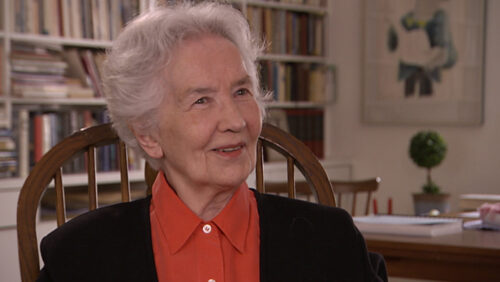
Download
Loading...
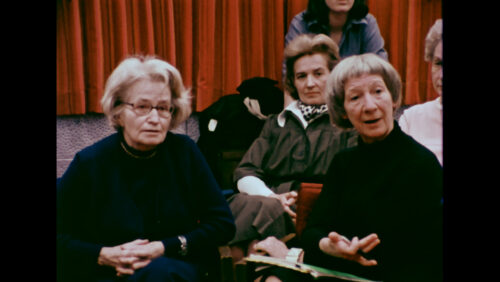
Download
Loading...
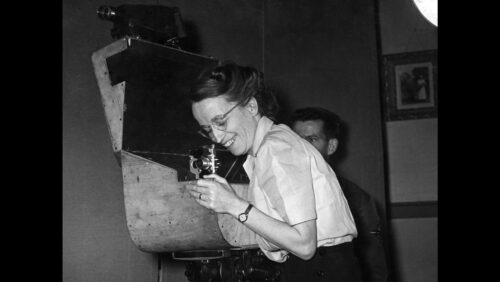
Download
Loading...
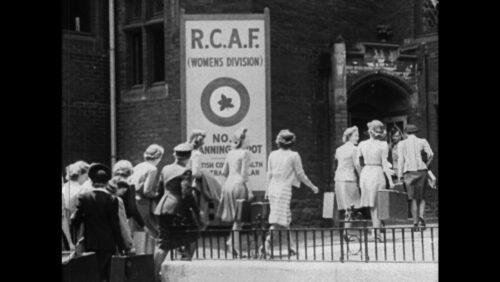
Download
Loading...
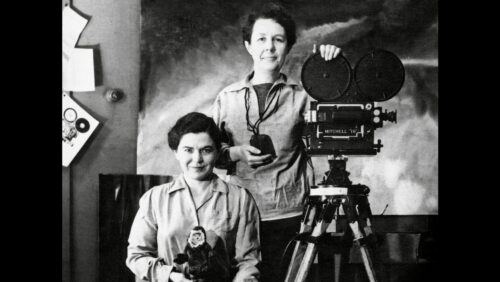
Download
Loading...

Download
Loading...
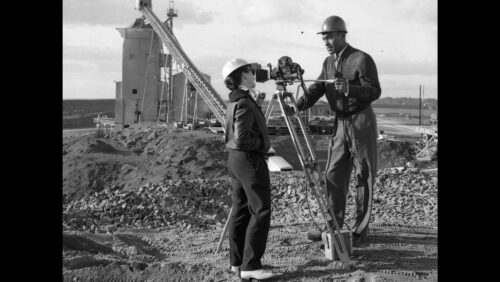
Download
Team
Donald McWilliams
Director
Photo
Kat Baulu
Producer
Photo
Photo : NFB
Ariel Nasr
Producer (NFB)
Photo
Photo : Kiana Hayeri
Annette Clarke
Producer and Executive Producer
Photo
Photo : Dave Howells
Rohan Fernando
Executive Producer
Photo
Photo : Meghan Tansey Whitton
Nathalie Cloutier
Executive Producer
Photo
Photo : Valérie Sangin
Credits
Written, Directed and Edited by
Donald McWilliams
Original Idea
Script and Editing Consultant
Michelle van Beusekom
Graphic Design and Animation
Mélanie Bouchard
Research
Alison Burns
Donald McWilliams
Photographic Research
Josée Laliberté
Music
Melissa Hui
Sound Design
Sacha Ratcliffe
Additional Music
Phyllis Gummer
Narration
Clare Coulter
Donald McWilliams
Voice and Music Recording
Geoffrey Mitchell
Luc Léger
Bernard Belley
Re-recording
Jean-Paul Vialard
Online Editor
Serge Verrault
Four Days in May
Group Discussion Leader
Susan Schouten
Camera
Nesya Shapiro
Sound Recording
Ingrid Cusiel
Technical Coordinator
Daniel Lord
Digital Editing Technicians
Marie-Josée Gourde
Albert Kurian
Pierre Dupont
Patrick Trahan
Production
Annette Clarke
Ariel Nasr
Katherine Baulu
Marching the Women inspired by
MARCHING THE COLOURS (1942)
Animated by GUY GLOVER
Dedicated to the NFB Women with a special tip of a Top Hat to their families & friends
Carleen Baily
Christina Benseler
Nina Beveridge
Heather Brinkman
Barbara Burns
Michael Burns
Catherine Lloyd Burns
William Cherry
Laverne Cherry
Jennifer Crawley
Sandy Crawley
David Crone
Robert Crone
Vi Crone
Mark Connell
Julia Elton
Rebecca Fitzsimons
Leanna Griffiths
Judith Hammill
Ruth Hawthorne
Alexandra Jacobs
Laura Kutnick
Andrew Leigh
Jacob Leigh
D’Arcy Mars
Jessica Marsh
Anne McLaughlin
Deidre Newman
Dan O’Sullivan
Peter Osberg
Julia Parker
Martha Parker
Doreen Player
Bob Rae
Roslyn Rosenfeld
Nora Spence
James Spottiswoode
Maria Turtschaninoff
Robert Verrall
Tamarack Verrall
Margaret Waggoner
Monika Wagner
Archives
Mirrorpix
Philip Pocock
Getty Images
Reginald Balch
VisitBritain/TIDA
Ottawa Art Gallery
Periscope Film, LLC
BFI National Archive
National Gas Archive
Nova Scotia Archives
Beevision Productions
Estate of Alma Duncan
Mary Pickford Foundation
National Gallery of Canada
National Film Board of Canada
John Maltby / RIBA Collections
GP archives – collection Gaumont
The Vienna Philharmonic Orchestra
United Nations Audiovisual Library
Chuck Painter Stanford News Service
Provincial Archives of New Brunswick
University of Stirling – Grierson Archive
Yves Lapointe McGill Rare Books Library
Yle – The Finnish Broadcasting Company
Hazen Sise/Library & Archives Canada/PA-151359
Arthur Roy Library & Archives Canada Lynn Lafontaine
New York University Oral History Project (NYU Media Production)
Film and Its Techniques Raymond Spottiswoode/University of California Press
Gudrun Bjerring Parker Interview
Directed by Nina Beveridge
Interviewer Kirwan Cox
Arla Saare from Gamla Karleby
Directed by Christine Sarrukka
Laura Boulton
filmed with the Inuit on & around Southampton Island, Baffin Island, Coats Island, Chesterfield, Baker Lake and Fort Churchill.
And with the Haida
In Masset, Skidegate, and Lax Kw’alaams, B.C.
The Magical Eye
Directed by Terence Macartney-Filgate
National Film Board of Canada & Canadian Broadcasting Corporation
Musicians
Krystina Marcoux, percussion
Andrew King, trumpet
Jeffrey Stonehouse, flute
David Potvin, piano
Stéphanie Bozzini, viola
Isabelle Bozzini, cello
Clemens Merkel, violin
Alissa Cheung, violin
Additional Music
Kevin Dean Melancholy Memoir
Kevin Dean Since 1954
McGill Records
Les Biches
Francis Poulenc
Ireland RTE National Symphony Orchestra
Jean-Luc Tingaud, conductor
Courtesy of Naxos of America, Inc.
Quattro Versioni Originali Della Ritirata Notturna
Written by Luigi Boccherini
Arranged by Luciano Berio
Finnish Radio Symphony Orchestra
Hannu Lintu, conductor
Courtesy of Concord Music Group Inc.
The Fifth Province -Theme
Pierre Béluse Percussion
Christopher Best Cello
André Moisan Clarinet
Denise Lupien Violin
Florence Mallette Violin
Francine Lupien Viola
Dancing Negative Cutter
Eva Cvijanovic
Fred Casia
Additional Research
Nancy Marcotte
Katherine Kasirer
Claire Gray
Louise Moyes
Asia Mason
Archival Clearances
Elizabeth Klinck
Alison Burns
Nancy Marcotte
Music Rights Clearance
John Ciccone
A Tip of a Hat to
Terre Nash
Torill Kove
Olga Denisko
Donna Read
Anthony Kent
Parissa Mohit
Martha Moore
Hannele Halm
Dorothy Henaut
Donna Dudinsky
Adam Abouaccar
Jérôme Bretéché
Robert McLaughlin
Joanne Robertson
Alison Reiko Loader
Karina Garcia Casanova
Jennifer Vanderburgh
Director of Photography – Development
Michael Yaroshevsky
Head Technical Resources
Sylvain Desbiens
Coordinators Technical Resources
Isabelle Painchaud
Antonia Gueorguieva
Martin Forget
Marie-France Rousseau and all her team at
NFB Conservation and Digitization
André D’Ulisse and all the team at
NFB Institutional Archives
Archival Sound Digitization
Pierre St-Germain (Bidou)
Colourist and Timer
Sylvie Marie Fortier
Transcription
Lori Heath
Additional Technical Coordination
Christopher MacIntosh
Luc Binette
Production Supervisor
Roz Power
Senior Production Coordinator
Cheryl Murgatroyd
Production Coordinators
Yanis Ait Mohamed
Christine Williams
Associate Producer
Kelly Davis
Studio Administrator
Leslie Anne Poyntz
Marketing Manager
Jamie Hammond
Marketing Coordinators
Jolène Lessard
Harmonie Hemming
Publicist
Osas Eweka-Smith
Legal Counsel
Dominique Aubry
Executive Producers Quebec Atlantic Studio
Annette Clarke
John Christou
Rohan Fernando
Nathalie Cloutier
-
About the NFB
For more than 80 years, the National Film Board of Canada (NFB) has produced, distributed and preserved those stories, which now form a vast audiovisual collection—an important part of our cultural heritage that represents all Canadians.
To tell these stories, the NFB works with filmmakers of all ages and backgrounds, from across the country. It harnesses their creativity to produce relevant and groundbreaking content for curious, engaged and diverse audiences. The NFB also collaborates with industry experts to foster innovation in every aspect of storytelling, from formats to distribution models.
Every year, another 50 or so powerful new animated and documentary films are added to the NFB’s extensive collection of more than 14,000 titles, half of which are available to watch for free on nfb.ca.
Through its mandate, its stature and its productions, the NFB contributes to Canada’s cultural identity and is helping to build the Canada of tomorrow.